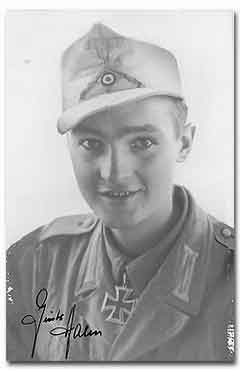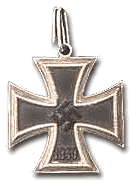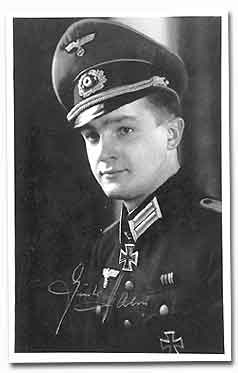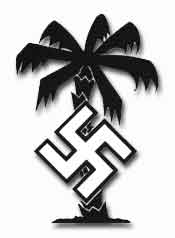Leutnant
Günter Halm
Träger des
Ritterkreuz des Eiserne Kreuze

Images courtesy of Günter
Halm




Günter Halm was born on 27 August 1922 in the small village of Elze, as the son of a Reichsbahnobersekretärs (chief secretary of the national railroad). When the war broke out in 1939, Halm was in the midst of an apprenticeship (maschineschloßer) that he successfully concluded around Easter 1941. Outside his profession, his interest in motorized vehicles was fully developed in the Hitler Jugend Motor Club 1/79, as a Senior Leader of Comradry.
In October 1941, Günter Halm volunteered for service in a Army motorized unit and was assigned to a Panzerjäger Ersatzabteilung (anti-tank replacement section). Shortly after completing his basic training at the end of April 1942, Halm was assigned to the Deutsche Afrika Korps (DAK), Pak-Zug (anti-tank platoon), Stabskompanie (Staff Company), Panzergrenadier-Regiment 104, under the command of Leutnant Skubiovius. The platoon consisted of two captured Russian heavy (14 hundredweights) 7,62-cm anti-tank guns. Halm was the cannonier for the first gun that commanded by the gun crew chief, Unteroffizier Jabeck. Difficult situations were mastered only when the cannonier could quickly acquire a the identified target (provided by the gun crew chief or platoon leader). As opposed to a dare devil, Grenadier Halm was a more indiscrete and shy individual. However, by 15 July 1942, Halm was awarded the Iron Cross II. Class after destroying his first 2 British tanks at Bir Hatcheim.
The North African theater of operations was especially active during this period. Generalfeldmarschall Erwin Rommel, OB Pz.Armee Afrika, at the height of his militray career, stood before the gates of Alexandria after the capture of Tobruk on 21 June 1942 and reaching El Alamein. GFM Rommel was advancing further into Egypt. The Allied General Sir Claude Auchinleck, commanding general of the British 8th Army launched a counterattack during the night on 22 July 1942 with strong British, Australian, South African, and Indian forces against the middle front of El Alamein that placed Rommel's already weakened German and Italian foces in danger. The Allies successfully made deep penetrations into the Italian position. Shortly thereafter, General Auchinleck committed to battle the fresh 23rd Tank Brigade that arrived from England, together with the 161rst Indian Brigade, in order to roll up the German 21.Panzer-Division, under the command of Generalmajor Georg v. Bismarck. More than 100 total Allied Mark II, IV, and Valentine tanks participated in the attack to breakthrough the German lines.
It was the greatest hour for the 19-year old Grenadier Halm. During the Allied attack, Grenadier Halm accounted for the destruction of 7 British tanks. Even after 2 comrades from his gun crew were wounded, Halm continued to fight with determination and assisted in replleing the attack. By 22 July 1942, a total of 146 Allied tanks were destroyed. By 27 July, approx. 1,400 prisoners were taken. During the following German counterattack on 28 July 1942, an additional 1000 prosiners were taken and 60 British tanks were destroyed. Those Allied tanks that were not destroyed by the Panzerjäger (tank hunters) were knocked out by German Panzer IV, 21.Pz.Div., and Stukas that interceeded during the battle.
On 23 July 1942, Halm received the Iron Cross I. Class from the regimental commander, Oberst Ewert. On 7 August 1942, Halm was decorated with the Knight's Cross to the Iron Cross. The prestigous award was hung around Halm's neck by General Rommel himself (and verbal promotion to Corporal), who was accompanied by the Italian Marshal Ugo Cavallero, General d.Pz.Tr. Walther K. Nehring, commanding general DAK Wilhelm Ritter v. Thoma, and Rommel's chief of staff, Oberst i.G. Kurt Westphal.
Promotions
1 July 1942
Gefreiter
1 November 1942 Unteroffizier
1 July 1943 Fahnenjunker
1 October 1943 Feldwebel
1 November 1943 Oberfähnrich
1 March 1944 Leutnant

Military
Career
4 August 1941 Panzerjäger-Abteilung Braunschweig
28 December 1942 DAK, Cannonier, Pz.Gren.Rgt.104, 21.Pz.Div.
until March 1943 hospitalized in Athens and Wien
August 1943 Fallschirmjäger-Lehrgang Wischau- Böhmen-Mähren
December 1943-March 1944 Oberfãhnrichs-Lehrgang Berlin
March 1944 France, Invasionfront: Ord.Offz., I./Pz.Gren.Rgt.192., 21.Pz.Div.
24 August 1944 POW in England and America
March 1946 Released from captivity and return home.

Copyright Stenger Historica 2004